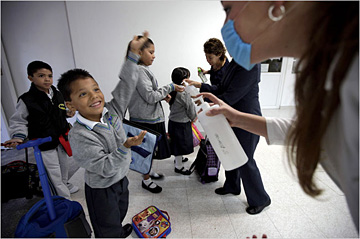
|  |  |  Health & Beauty | October 2009 Health & Beauty | October 2009  
Experience Guides Mexico as Swine Flu Cases Surge
 Marc Lacey & Antonio Betancourt - New York Times Marc Lacey & Antonio Betancourt - New York Times
go to original
October 08, 2009


| | To prevent the spread of swine flu, Mexican children were given antibacterial gel when school opened in late August. (Gregory Bull/Associated Press) |  |
Mexico City — The man in the hospital bed complained of muscle aches and a fever so high he was sweating into his sheets. Two other patients, also confirmed to be infected with the swine flu virus, shared a special room with him, cut off from the general population.

“What bothers me is that they treat us as if we had done something wrong,” said the man, Néstor Vázquez, 58, peering out from behind his covers last week.

Nearly six months have passed since Mexico, with the help of laboratories in the United States and Canada, discovered the presence of a mysterious influenza virus, an unknown strain that caused a spike in the number of flu cases at a time of year when they are usually in decline. Alarmed by the highly contagious new bug, whose lethality was then uncertain, the government closed schools and other public facilities, sent soldiers into the streets to hand out masks and urged Mexicans to cover their mouths if they sneezed or coughed and to forgo handshakes and, especially, kisses on the cheek.

 |  | Mass school and restaurant closings, which dealt a severe blow to Mexico’s economy, are out. So are calls for Mexicans to huddle in their homes. |  |  |  |
Mexico has had 245 deaths as of this week, helping make up the more than 4,100 deaths around the globe reported to the World Health Organization. But that is a relatively small number given the widespread contagion. For now, health experts remain most concerned with stopping the spread and watching for the possibility of the virus’s mutating into a more lethal strain.

With the number of cases surging again in Mexico — September had more new cases, 9,231, than any previous month — the government says it has learned important lessons about what works and what does not when it comes to the strain, H1N1. Mass school and restaurant closings, which dealt a severe blow to Mexico’s economy, are out. So are calls for Mexicans to huddle in their homes.

Instead, the government says it is adopting more focused measures, like keeping confirmed carriers like Mr. Vázquez temporarily under quarantine.

“I guess they just don’t want us to contaminate anyone,” said Mr. Vázquez, interviewed by a reporter who was himself in the hospital to be tested for swine flu. (The results were negative.) Some hospitals issue “Negativo” certificates to those who have been cleared, to be shown to teachers, employers or airlines.

Early in the outbreak, when fear was rampant, seven million children in and around the capital were kept home from school. Now, individual schools and school districts close only when multiple cases are found. The states most affected have been scattered around the country, from Chiapas to Jalisco and from Mexico City to Yucatán, officials say.

“We’re not taking drastic measures,” Dr. José Ángel Córdova, Mexico’s health minister, said in a recent interview. “With our past experience, we have learned that this is a relatively benign illness and that there are measures of control that are not that effective and others, like washing your hands, that work.”

The blue masks that were so ubiquitous across the capital months ago — Dr. Córdova used to have one strung around his neck as he briefed the news media on the latest death figures — are now relatively rare outside of hospitals. President Felipe Calderón, who avoided shaking hands during the height of the crisis, has begun pressing the flesh again.

Health officials are urging calm, especially because there will not be nearly enough vaccine available to cover the entire population. They are sending the message that although H1N1 carries serious risks, so do many other health threats. More people die from obesity and tobacco-related illnesses in a typical year, they say, than from influenza.

Coughs in public places still cause alarm, and health officials say that their studies have shown that coughing, fever and breathing difficulties were the three main symptoms exhibited by those infected people who died. But they also said that most of those people were found to have had underlying medical conditions that complicated their cases. |

 |
|  |



